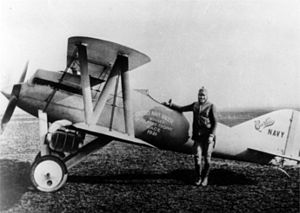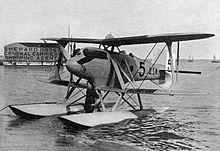- Curtiss CR
-
Model 23, CR, R-6 The CR-1 with Bert Acosta, 1921 Role Racing aircraft Manufacturer Curtiss First flight 1921 Primary user United States Navy Number built 4 The Curtiss CR was a racing aircraft designed for the United States Navy in 1921. It was a conventional single-seater biplane with a monocoque fuselage and staggered single-bay wings of equal span braced with N-struts. Two essentially similar landplane versions were built as the CR-1 and CR-2, which were both eventually converted to seaplanes as the CR-3 in 1923 and CR-4 in 1924. A refined version was developed for the US Army Air Service under the designation R-6. These latter two aircraft featured refined aerodynamics included surface-mounted radiators.
Operational history
The Curtiss CRs enjoyed successful racing careers. Their first major win was at the 1921 Pulitzer Trophy race, where piloted by Bert Acosta the CR-1 took first place with an average speed of 176.75 mph (283.49 km/h), nearly two minutes ahead of its closest rival. The following year, this aircraft was modified and redesignated CR-2 and joined in the Pulitzer race by a second aircraft built to the same new standard, plus two R-6s flown by Army pilots. These Curtiss aircraft took first through fourth place, the two R-6s followed by the two CR-2s. The race was won by Lt. Russell Maughan with an average speed of 205.856 mph (330,172 km/h) with Lt. Lester Maitland in second place (198.850 mph/318.936 km/h). Maughan's effort incidentally broke every closed-circuit airspeed record up to 124 mi (200 km). The CR-2s took third and fourth places piloted by Lt Harold Brow (average speed 193.695 mph/310.667 km/h) and Lt Jg Al Williams (average speed 187.996 mph/301.527 km/h).
The Army built upon this success with the R-6s by using the aircraft to break the world airspeed record before 1922 was out, Gen William Mitchell flying one to 224.28 mph (359.72 km/h) on 18 October. In March the following year, an R-6 flown by Lt. Maughan lifted the record to 236.587 mph (380.74 km/h). The R-6 design was developed in 1923 into the longed-winged XPW-8, the prototype of the PW-8 fighter.
In 1923, the CR-2s were fitted with floats for the Schneider Trophy race and redesignated CR-3. The aircraft took first and second place, piloted by David Rittenhouse (average speed 177.977 mph, 285.457 km/h) and Rutledge Irvine (173.932 mph, 278.970 km/h). Following this victory, one of the aircraft was further modified as the CR-4 for an attempt on the world airspeed record for seaplanes. It achieved this in 1924 with a speed of 188 mph.[citation needed]
Operators
- United States Navy (CR)
- United States Army (R6)
Specifications (CR.3 Seaplane)
Data from Curtiss Aircraft, 1907-1947[1]
General characteristics
- Crew: 1 (pilot)
- Length: 24 ft 8 in (7.52 m)
- Wingspan: 22 ft 8 in (6.90 m)
- Height: 10 ft 9 in (3.27 m)
- Wing area: 168 ft2 (15.6 m2)
- Empty weight: 2,119 lb (961 kg)
- Gross weight: 2,597 lb (1,178 kg)
- Powerplant: 1 × Curtiss D-12 5PL, 450 hp (336 kW)
Performance
- Maximum speed: 194 mph (312 km/h)
- Range: 281 miles (452 km)
- Service ceiling: 22,000 ft (6,706 m)
See also
- Related development
Curtiss R3C
- Aircraft of comparable role, configuration and era
- Gallaudet D-4
References
- Notes
- ^ Bowers 1979, p. 230.
- Bibliography
- Bowers, Peter M. (1979). Curtiss Aircraft, 1907–1947. London: Putnam & Company Ltd.. ISBN 0-370-10029-8.
- Taylor, Michael J. H. (1989). Jane's Encyclopedia of Aviation. London: Studio Editions. pp. 796.
- World Aircraft Information Files. London: Bright Star Publishing. pp. File 891, Sheet 45.
External links
Aircraft produced by Curtiss and Curtiss-Wright Manufacturer
designationsModel letters: C • D • E • F • G • GS • H • J • K • L • M • N • PN • JN • R • S
Model numbers: 1 • 2 • 3 • 4 • 5 • 6 • 7 • 8 • 9 • 10 • 11 • 12 • 13 • 14 • 16 • 17 • 18 • 19 • 20 • 21 • 23 • 24 • 26 • 28 • 31 • 32 • 33 • 34 • 35 • 36 • 37 • 38 • 39 • 40 • 41 • 42 • 43 • 44 • 47 • 48 • 49 • 50 • 51 • 52 • 53 • 54 • 55 • 56 • 57 • 58 • 59A/59B • 60 • 61 • 62 • 63 • 64 • 66 • 67 • 68 • 69 • 70 • 71 • 72 • 73 • 75 • 76 • 77 • 79 • 81 • 82 • 84 • 85 • 86 • 87 • 88 • 90 • 91 • 94 • 95 • 96 • 97 • 98 •
"CW" models: CW-1 • CW-2 • CW-3 • CW-4 • CW-5 • CW-6 • CW-7 • CW-8 • CW-9 • CW-10 • CW-11 • CW-12 • CW-14 • CW-15 • CW-16 • CW-17 • CW-18 • CW-19 • CW-20 • CW-21 • CW-22 • CW-23 • CW-24 • CW-25 • CW-27 • CW-29 • CW-32
By role Experimental: No. 1 • Model C • Tanager
Racing: No. 2 • CR • R2C • R3C
General utility: Model D • Model E • Model F • Robin • Thrush
Maritime patrol: Model H • HS-1L and -2L
Training: Model L • Model JN • Fledgling • AT-4 Hawk • AT-5 Hawk
Fighters: 18 • PW-8 • P-1 • P-2 • P-3 • P-4 • P-5 • P-6 • XP-31 • P-36 • P-40 • XP-46 • XP-53 • YP-60 • XP-62 • XP-71 • XP-87
Naval Fighters: HA • FC • F2C • F3C • F4C • F6C • F7C • F8C • F9C • F10C • F11C • XF12C • F13C • XF14C • XF15C
Airliners: Eagle • Condor II • Kingbird
Naval Scouts/Dive Bombers: CS • GS • S2C • XS3C • S4C • SC • SBC • SB2C • XSB3C • SOC • SO2C • SO3C
Observation: O-1 • O-12 • O-13 • O-16 • O-18 • O-26 • O-39 • O-40 • O-52
Naval Observation: OC • O2C • O3C
Naval Bombers: 24 • BFC • BF2C • XBTC • XBT2C
Ground Attack: A-3 • A-4 • A-5 • A-6 • A-8 • YA-10 • A-12 • YA-14 • A-25 • A-40 • XA-43
Licensed production: NBS-1
USAAS racing aircraft designations 1919-1924 USN racing aircraft designations Bee Line BR
Curtiss Lists relating to aviation General Aircraft (manufacturers) · Aircraft engines (manufacturers) · Airlines (defunct) · Airports · Civil authorities · Museums · Registration prefixes · Rotorcraft (manufacturers) · TimelineMilitary Accidents/incidents Records Categories:- Schneider Trophy
- United States sport aircraft 1920–1929
- Curtiss aircraft
- Single-engine aircraft
Wikimedia Foundation. 2010.



